You must be logged in to post a review.
€68.00
Figure to assemble and paint
Ref.: 9 – TC
Weight: 190 grs.
Material: White Metal
poff Pieces: 22
Historical Review:
On 30 June 1911, the creation of an indigenous force made up of four infantry companies and a cavalry squadron was decreed. A prestigious soldier was appointed to command and organise this experimental unit: Lieutenant Colonel Dámaso Berenguer Fusté. Melilla was the point chosen for the concentration and training of the new troops. In October of that same year, the battalion already had 20 chiefs and officers, 300 indigenous soldiers and 127 horses. This troop had taken the name of FUERZAS REGULARES INDIGENAS (REGULAR INDIGENOUS FORCES).
In 1914, the Regular forces were expanded with the creation of four groups. Each of these four groups consisted of two Infantry Tabors of three companies plus a cavalry Tabor of three squadrons. They always fought in the vanguard of our troops. Specifically, the Groups of Regular Indian Forces were constituted as follows:
- 1st Indigenous Regular Forces “Tetuan”, quartered in Tetuan.
- 2nd Indigenous Regular Forces “Melilla”, Melilla and Nador.
- 3rd Indigenous Regular Forces “Ceuta”, Ceuta.
- 4th Indigenous Regular Forces “Larache”, Asilah and Larache.
In 1921, after the Annual Disaster, one more unit was created:
- -5th Indigenous Regular Forces “Alhucemas”, Segangan.
The Ceuta Regular Forces Group No. 3 was one of the units that participated intensively in the Moroccan campaigns until the end of the operations in 1927. It would later intervene in the repression of the Asturian Revolution of October 1934 and in the Spanish Civil War. The unit would serve for seventy years, remaining in Ceuta until its disbandment in July 1985, becoming part of the current 54th Regulars Group.
The Asturias Revolution was a workers’ insurrection that took place in Asturias in October 1934 as part of the general revolutionary strike organized by the Socialists (PSOE) throughout Spain known as the October Revolution of 1934 and which only took root in Asturias, mainly because the anarchist CNT did join the Workers’ Alliance proposed by the UGT Socialists and the PSOE, unlike in the rest of Spain. Hence the form of social and political organization of the Asturian Commune – the name by which the Asturian Revolution is also known, because of its similarities with the Paris Commune of 1871 – was the establishment of a socialist regime in the localities where the socialists (or communists) predominated, such as Mieres, where the Socialist Republic was proclaimed, or Sama de Langreo; or a libertarian communist one where the anarcho-syndicalists of the CNT predominated, as in Gijón and above all in La Felguera.
It was harshly repressed by the government, resorting, by decision of the minister of war and General Franco who directed the military operations from Madrid to Moroccan colonial troops – the regulars of the Army of Africa – and the Legion from Spanish Morocco. Despite being defeated, the Asturias Revolution became almost a myth for the Spanish and European working-class left, on a par with the Paris Commune or the Petrograd Soviet of 1917, as it was the ‘last social revolution, harshly stifled and annihilated, in Western Europe’.
The figure is taken from a photograph showing a column of the Cavalry Tabor of the Ceuta Group marching along the road from Mieres to Oviedo in 1934, during the quelling of the uprisings in Asturias. This photograph is reproduced by Jose María Bueno in his book: LOS REGULARES. Uniforms and organization of the Regular Troops Indigenous to Morocco.
It depicts a corporal standard bearer. It is worth noting that the figure has the carabiner bolt mechanism covered by a leather sheath (to protect it from the abundant rain in the region) and the sulham rolled up on the rump of the saddle. The photograph shows six horsemen, three of whom are wearing the chechia, which had already evolved into the later tarbuch, and three of whom are wearing the turban like the one in the figure.

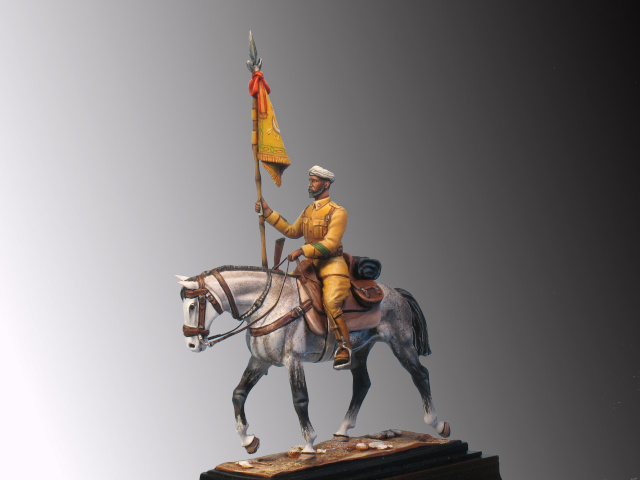
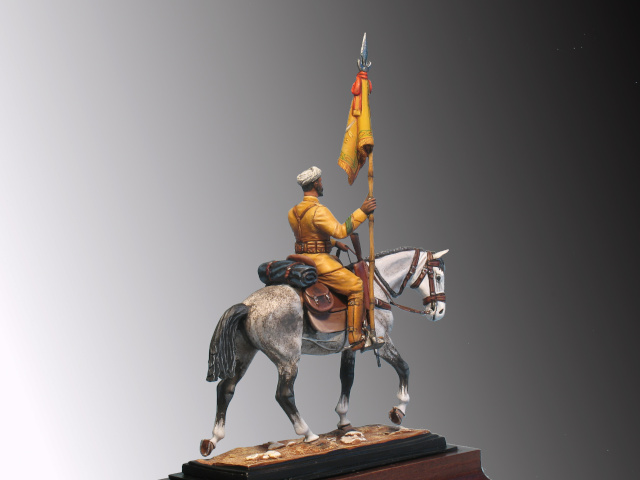
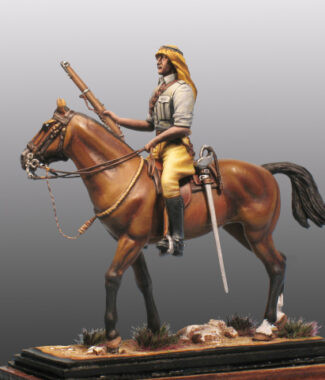
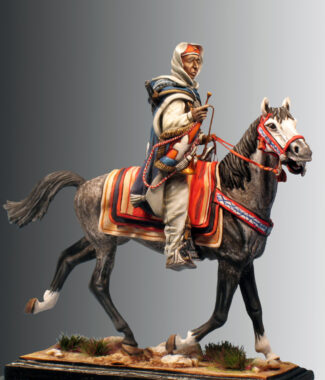
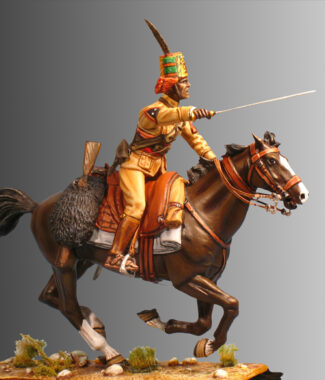
Reviews
There are no reviews yet.